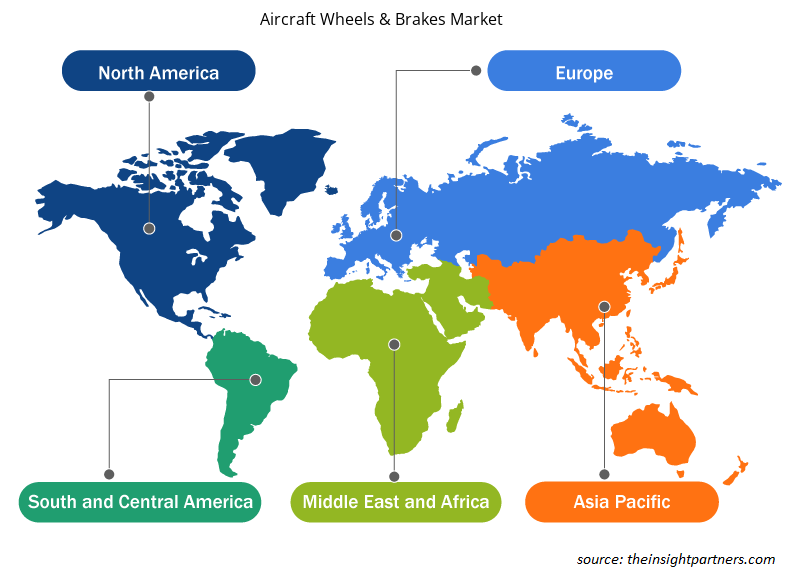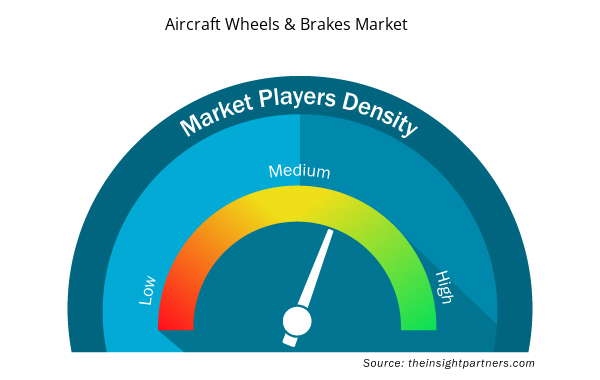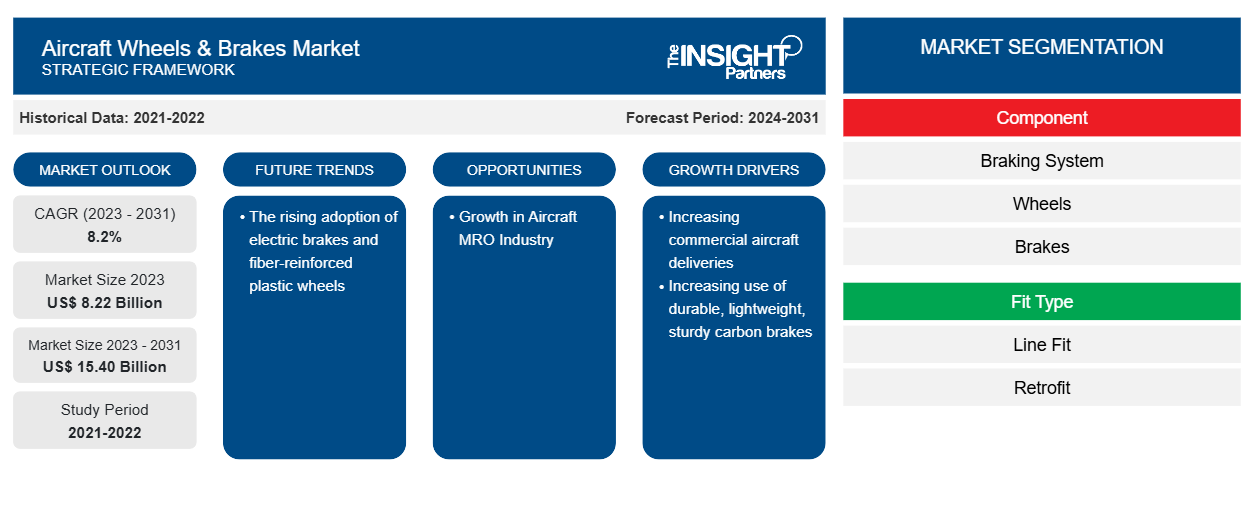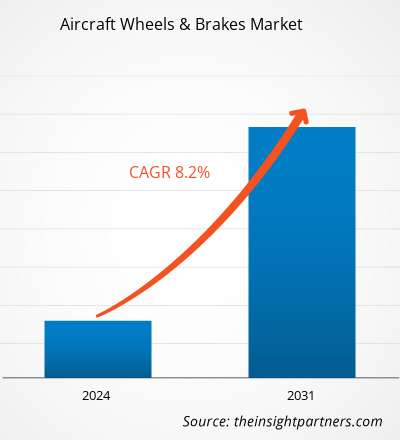Si prevede che il mercato delle ruote e dei freni per aeromobili raggiungerà i 15,40 miliardi di dollari entro il 2031, passando dagli 8,22 miliardi di dollari del 2023. Si prevede che il mercato registrerà un CAGR dell'8,2% nel periodo 2023-2031. È probabile che la crescente adozione di freni elettrici e ruote in plastica rinforzata con fibre rimanga una tendenza chiave nel mercato.CAGR of 8.2% during 2023–2031. The rising adoption of electric brakes and fiber-reinforced plastic wheels is likely to remain a key trend in the market.
Analisi di mercato delle ruote e dei freni per aeromobili
Il mercato delle ruote e dei freni per aeromobili è dominato principalmente da attori affermati come Honeywell International Inc, Parker Hannifin Corporation, Safran Group e Crane Aerospace & Electronics, tra gli altri. La domanda di ruote e freni tra i produttori di aeromobili è in forte aumento. Tuttavia, la maggior parte dei contratti viene assegnata a attori affermati. Inoltre, la produzione di queste ruote e freni richiede la conformità a diversi standard stabiliti dall'autorità di governo. Ciò comporta l'ottenimento di varie certificazioni e investimenti significativi in R&S, che limitano l'ingresso di nuovi attori nel settore. Pertanto, la minaccia per il business dei nuovi entranti è elevata nello scenario attuale; tuttavia, con l'aumento del volume di produzione di aeromobili, è prevista l'emergere di nuovi attori. Si prevede che ciò ridurrà la minaccia per i nuovi entranti poiché diversi produttori di aeromobili di piccole o medie dimensioni si acquisteranno le loro ruote e freni da nuovi entranti che offrono ruote e freni con tecnologia avanzata a un prezzo competitivo.
Panoramica del mercato delle ruote e dei freni per aeromobili
L'ecosistema del mercato delle ruote e dei freni per aeromobili comprende i seguenti stakeholder: fornitori di materie prime e componenti, produttori di ruote e freni per aeromobili, produttori di aeromobili e utenti finali. I produttori di ruote e freni per aeromobili si procurano materie prime e componenti come acciaio, alluminio, lega di magnesio e materiali di carbonio, tra gli altri, e componenti come sensori e attuatori, tra gli altri, provengono da vari fornitori di materie prime e componenti. I produttori di ruote e freni per aeromobili assemblano materie prime e componenti e li trasformano in prodotti finiti. I produttori di ruote e freni per aeromobili lavorano in tandem con le autorità aeronautiche, i fornitori di materie prime, i produttori di aeromobili e gli utenti finali. Tra i principali attori che operano nel mercato ci sono Collins Aerospace, Honeywell International Inc, Safran Group e Parker Hannifin Corporation, tra gli altri. Inoltre, i produttori di aeromobili si procurano ruote e freni dai player sopra menzionati e li installano sulla flotta di aeromobili tramite attività di adattamento della linea. Infine, gli utenti finali come compagnie aeree, forze armate di vari paesi e fornitori di servizi MRO acquisiscono contratti per attività MRO di ruote e freni per aeromobili. I fornitori di servizi di manutenzione, riparazione e revisione (MRO) acquistano continuamente ruote e freni dagli operatori del mercato per poter continuare a offrire i propri servizi in risposta alla domanda in continua crescita di ruote e freni per aeromobili.
Personalizza questo report in base alle tue esigenze
Riceverai la personalizzazione gratuita di qualsiasi report, comprese parti di questo report, o analisi a livello nazionale, pacchetto dati Excel, oltre a usufruire di grandi offerte e sconti per start-up e università
- Scopri le principali tendenze di mercato in questo rapporto.Questo campione GRATUITO includerà analisi di dati che spaziano dalle tendenze di mercato alle stime e alle previsioni.
Approfondimenti regionali sul mercato delle ruote e dei freni per aeromobili
Le tendenze regionali e i fattori che influenzano il mercato Aircraft Wheels & Brakes durante il periodo di previsione sono stati ampiamente spiegati dagli analisti di Insight Partners. Questa sezione discute anche i segmenti e la geografia del mercato Aircraft Wheels & Brakes in Nord America, Europa, Asia Pacifico, Medio Oriente e Africa e Sud e Centro America.

- Ottieni i dati specifici regionali per il mercato delle ruote e dei freni degli aeromobili
Ambito del rapporto di mercato sulle ruote e sui freni degli aeromobili
| Attributo del report | Dettagli |
|---|---|
| Dimensioni del mercato nel 2023 | 8,22 miliardi di dollari USA |
| Dimensioni del mercato entro il 2031 | 15,40 miliardi di dollari USA |
| CAGR globale (2023-2031) | 8,2% |
| Dati storici | 2021-2022 |
| Periodo di previsione | 2024-2031 |
| Segmenti coperti | Per componente
|
| Regioni e Paesi coperti | America del Nord
|
| Leader di mercato e profili aziendali chiave |
|
Densità degli attori del mercato: comprendere il suo impatto sulle dinamiche aziendali
Il mercato Aircraft Wheels & Brakes Market sta crescendo rapidamente, spinto dalla crescente domanda degli utenti finali dovuta a fattori quali l'evoluzione delle preferenze dei consumatori, i progressi tecnologici e una maggiore consapevolezza dei vantaggi del prodotto. Con l'aumento della domanda, le aziende stanno ampliando le loro offerte, innovando per soddisfare le esigenze dei consumatori e capitalizzando sulle tendenze emergenti, il che alimenta ulteriormente la crescita del mercato.
La densità degli operatori di mercato si riferisce alla distribuzione di aziende o società che operano in un particolare mercato o settore. Indica quanti concorrenti (operatori di mercato) sono presenti in un dato spazio di mercato in relazione alle sue dimensioni o al valore di mercato totale.
Le principali aziende che operano nel mercato delle ruote e dei freni per aeromobili sono:
- Beringer Aero
- Azienda aerospaziale Collins
- Honeywell International Inc.
- Società a responsabilità limitata Meggitt
- Società Parker Hannifin
Disclaimer : le aziende elencate sopra non sono classificate secondo un ordine particolare.

- Ottieni la panoramica dei principali attori del mercato delle ruote e dei freni per aeromobili
Notizie e sviluppi recenti sul mercato delle ruote e dei freni per aeromobili
Il mercato delle ruote e dei freni per aeromobili viene valutato raccogliendo dati qualitativi e quantitativi dopo la ricerca primaria e secondaria, che include importanti pubblicazioni aziendali, dati associativi e database. Di seguito sono elencati alcuni degli sviluppi nel mercato delle ruote e dei freni per aeromobili:
- Safran Landing Systems ha inaugurato, presso il suo sito di Vélizy-Villacoublay (Francia), un laboratorio completamente rinnovato, dedicato ai test delle sue ruote e dei freni in carbonio, e dotato di un nuovo banco di prova. L'azienda avrà investito un totale di 10 milioni di euro per realizzare questo ambizioso progetto. Il risultato è un ambiente di lavoro responsabile e la promessa di rafforzare la capacità di Safran di sviluppare e qualificare freni più performanti, più durevoli e competitivi, nonché di tenere il passo con i ramp-up dei suoi clienti. Ciò vale per quasi tutti i segmenti dell'aviazione civile, militare e commerciale. (Fonte: Safran, comunicato stampa, aprile 2024)
- Parker-Hannifin Corporation (NYSE: PH, "Parker"), leader mondiale nelle tecnologie di movimento e controllo, ha annunciato oggi di aver completato la transazione precedentemente annunciata per vendere la sua divisione Aircraft Wheel and Brake, con sede ad Avon, Ohio, negli Stati Uniti, a Kaman Corporation (NYSE: KAMN). Kaman, con sede a Bloomfield, Connecticut, è un produttore leader di componenti e materiali per i mercati aerospaziale e della difesa, industriale e medico. (Fonte: Parker-Hannifin Corporation, comunicato stampa, settembre 2022)
Copertura e risultati del rapporto di mercato sulle ruote e sui freni degli aeromobili
Il rapporto "Dimensioni e previsioni del mercato delle ruote e dei freni per aeromobili (2021-2031)" fornisce un'analisi dettagliata del mercato che copre le seguenti aree:
- Dimensioni e previsioni del mercato delle ruote e dei freni per aeromobili a livello globale, regionale e nazionale per tutti i segmenti di mercato chiave coperti dall'ambito
- Tendenze del mercato delle ruote e dei freni per aeromobili, nonché dinamiche di mercato come conducenti, sistemi di ritenuta e opportunità chiave
- Analisi dettagliata delle cinque forze di Porter
- Analisi di mercato del mercato delle ruote e dei freni per aeromobili che copre le principali tendenze del mercato, il quadro globale e regionale, i principali attori, le normative e i recenti sviluppi del mercato
- Analisi del panorama industriale e della concorrenza che copre la concentrazione del mercato, l'analisi della mappa di calore, i principali attori e gli sviluppi recenti per il mercato delle ruote e dei freni degli aeromobili
- Profili aziendali dettagliati
- Analisi storica (2 anni), anno base, previsione (7 anni) con CAGR
- Analisi PEST e SWOT
- Valore/volume delle dimensioni del mercato - Globale, regionale, nazionale
- Industria e panorama competitivo
- Set di dati Excel


- Public Key Infrastructure Market
- Queue Management System Market
- Customer Care BPO Market
- Truck Refrigeration Market
- Electronic Data Interchange Market
- Architecture Software Market
- Artificial Intelligence in Healthcare Diagnosis Market
- Integrated Platform Management System Market
- Dried Blueberry Market
- Fish Protein Hydrolysate Market

Report Coverage
Revenue forecast, Company Analysis, Industry landscape, Growth factors, and Trends

Segment Covered
This text is related
to segments covered.

Regional Scope
North America, Europe, Asia Pacific, Middle East & Africa, South & Central America

Country Scope
This text is related
to country scope.
Domande frequenti
The aircraft wheels & brakes market is likely to register of 8.2% during 2023-2031.
The estimated value of the aircraft wheels & brakes market by 2031 would be around US$ 15.40 billion.
The rising adoption of electric brakes and fiber-reinforced plastic wheels is one of the major trends of the market.
Honeywell International Inc, Parker Hannifin Corporation, Safran, Collins Aerospace, Beringer Aero, Crane Aerospace and Electronics, Grove Aircraft Landing Gear Systems Inc, Jay-Em Aerospace and Machine Inc, Matco Manufacturing Inc, and TransDigm Group Incorporated are some of the key players profiled under the report.
Increasing commercial aircraft deliveries and increasing use of durable, lightweight, sturdy carbon brakes are some of the factors driving the growth for aircraft wheels & brakes market.
Asia Pacific region dominated the aircraft wheels & brakes market in 2023.
Trends and growth analysis reports related to Aerospace and Defense : READ MORE..
The Insight Partners performs research in 4 major stages: Data Collection & Secondary Research, Primary Research, Data Analysis and Data Triangulation & Final Review.
- Data Collection and Secondary Research:
As a market research and consulting firm operating from a decade, we have published and advised several client across the globe. First step for any study will start with an assessment of currently available data and insights from existing reports. Further, historical and current market information is collected from Investor Presentations, Annual Reports, SEC Filings, etc., and other information related to company’s performance and market positioning are gathered from Paid Databases (Factiva, Hoovers, and Reuters) and various other publications available in public domain.
Several associations trade associates, technical forums, institutes, societies and organization are accessed to gain technical as well as market related insights through their publications such as research papers, blogs and press releases related to the studies are referred to get cues about the market. Further, white papers, journals, magazines, and other news articles published in last 3 years are scrutinized and analyzed to understand the current market trends.
- Primary Research:
The primarily interview analysis comprise of data obtained from industry participants interview and answers to survey questions gathered by in-house primary team.
For primary research, interviews are conducted with industry experts/CEOs/Marketing Managers/VPs/Subject Matter Experts from both demand and supply side to get a 360-degree view of the market. The primary team conducts several interviews based on the complexity of the markets to understand the various market trends and dynamics which makes research more credible and precise.
A typical research interview fulfils the following functions:
- Provides first-hand information on the market size, market trends, growth trends, competitive landscape, and outlook
- Validates and strengthens in-house secondary research findings
- Develops the analysis team’s expertise and market understanding
Primary research involves email interactions and telephone interviews for each market, category, segment, and sub-segment across geographies. The participants who typically take part in such a process include, but are not limited to:
- Industry participants: VPs, business development managers, market intelligence managers and national sales managers
- Outside experts: Valuation experts, research analysts and key opinion leaders specializing in the electronics and semiconductor industry.
Below is the breakup of our primary respondents by company, designation, and region:

Once we receive the confirmation from primary research sources or primary respondents, we finalize the base year market estimation and forecast the data as per the macroeconomic and microeconomic factors assessed during data collection.
- Data Analysis:
Once data is validated through both secondary as well as primary respondents, we finalize the market estimations by hypothesis formulation and factor analysis at regional and country level.
- Macro-Economic Factor Analysis:
We analyse macroeconomic indicators such the gross domestic product (GDP), increase in the demand for goods and services across industries, technological advancement, regional economic growth, governmental policies, the influence of COVID-19, PEST analysis, and other aspects. This analysis aids in setting benchmarks for various nations/regions and approximating market splits. Additionally, the general trend of the aforementioned components aid in determining the market's development possibilities.
- Country Level Data:
Various factors that are especially aligned to the country are taken into account to determine the market size for a certain area and country, including the presence of vendors, such as headquarters and offices, the country's GDP, demand patterns, and industry growth. To comprehend the market dynamics for the nation, a number of growth variables, inhibitors, application areas, and current market trends are researched. The aforementioned elements aid in determining the country's overall market's growth potential.
- Company Profile:
The “Table of Contents” is formulated by listing and analyzing more than 25 - 30 companies operating in the market ecosystem across geographies. However, we profile only 10 companies as a standard practice in our syndicate reports. These 10 companies comprise leading, emerging, and regional players. Nonetheless, our analysis is not restricted to the 10 listed companies, we also analyze other companies present in the market to develop a holistic view and understand the prevailing trends. The “Company Profiles” section in the report covers key facts, business description, products & services, financial information, SWOT analysis, and key developments. The financial information presented is extracted from the annual reports and official documents of the publicly listed companies. Upon collecting the information for the sections of respective companies, we verify them via various primary sources and then compile the data in respective company profiles. The company level information helps us in deriving the base number as well as in forecasting the market size.
- Developing Base Number:
Aggregation of sales statistics (2020-2022) and macro-economic factor, and other secondary and primary research insights are utilized to arrive at base number and related market shares for 2022. The data gaps are identified in this step and relevant market data is analyzed, collected from paid primary interviews or databases. On finalizing the base year market size, forecasts are developed on the basis of macro-economic, industry and market growth factors and company level analysis.
- Data Triangulation and Final Review:
The market findings and base year market size calculations are validated from supply as well as demand side. Demand side validations are based on macro-economic factor analysis and benchmarks for respective regions and countries. In case of supply side validations, revenues of major companies are estimated (in case not available) based on industry benchmark, approximate number of employees, product portfolio, and primary interviews revenues are gathered. Further revenue from target product/service segment is assessed to avoid overshooting of market statistics. In case of heavy deviations between supply and demand side values, all thes steps are repeated to achieve synchronization.
We follow an iterative model, wherein we share our research findings with Subject Matter Experts (SME’s) and Key Opinion Leaders (KOLs) until consensus view of the market is not formulated – this model negates any drastic deviation in the opinions of experts. Only validated and universally acceptable research findings are quoted in our reports.
We have important check points that we use to validate our research findings – which we call – data triangulation, where we validate the information, we generate from secondary sources with primary interviews and then we re-validate with our internal data bases and Subject matter experts. This comprehensive model enables us to deliver high quality, reliable data in shortest possible time.


 Ottieni un campione gratuito per questo repot
Ottieni un campione gratuito per questo repot